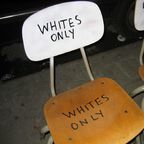About a year ago, I received an invitation to contribute a few encyclopedia-type entries for a book about race and ethnicity (information available at end of post). One of the requested topics was "whiteness," a topic both obvious—how can a book about race not examine whiteness?—and curious, for I was quite sure that there would be no similar entries for "blackness" or "Asian-ness". Whiteness, you see, is a unique concept and explaining it poses unique challenges. Below is my attempt, in 500 words
It is customary to begin an essay of this sort with a definition, but who gets to define whiteness? In contemporary progressive circles, it is generally assumed that a group should be able to define itself, but whiteness has historically been defined by non-whites. For example, James Weldon Johnson, an African American poet and anthologist observed in 1912 that "The colored people of this country know and understand the white people better than the white people will ever know and understand themselves." In the past 20 years, many white writers and scholars have embraced the study of whiteness, but people of color, particularly Black writers and academics continue to make significant (at times, even primary) contributions to this area of scholarship.
There are several different components of whiteness. These include: 1) racial identity, 2) racial bias, and 3) racial privilege.
The "Whiteness as Group Identity" model conceptualizes whiteness as one of many different racial identities, the strength of which is determined by four factors: group size, group power, group discrimination, and group appearance. According to this model, those who are part of a group that is the numerical minority, has less power relative to other groups, experiences more discrimination, and less phenotypically resembles the majority group, should have a greater sense of racial identity, while those who are part of the racial majority (and all its privileges) should put very little emphasis on their racial identity. Indeed, though self-identified white supremacists and anti-racism activists are notable exceptions, many white Americans much more strongly prefer to identify as "American" or as a humanist than as "white".
In contrast to the neutrality of the group identity model, a number of writers and activists have equated whiteness with a racist ideology. They argue that the U.S. society is characterized by a socially created racial hierarchy that values whiteness above all others and that because whites are socialized (via family, peers, media) into this society, they cannot help but internalize some of the messages about white superiority, even if they consciously reject racist beliefs. Though controversial (especially in conservative circles), a number of cleverly designed empirical studies, most notably those using the Implicit Association Test (IAT), have supported the notion that most white people show unconscious (and therefore unintentional) bias in favor of those who are white, a bias that is either not evident or significantly smaller, in non-white groups.

Because of the racial socialization described above, the "whiteness as privilege" model posits that whiteness is characterized not so much by racial bias (i.e., racism) but by racial privilege. In her now classic "Invisible Knapsack" paper, Peggy McIntosh identified several dozen specific privileges associated with whiteness, including, for example, the privilege of learning about the important contributions of one's people in schools, but probably the two primary privileges are 1) the privilege to assume that whiteness is the norm against which everyone else should be compared and 2) the privilege to live one's life without ever needing to be aware of one's whiteness and how it might be impacting their life.
In order to describe the various world-views associated with whiteness and the developmental process though which these world-views sometimes change, a number of white racial identity models have been developed, most notably by Janet Helms who argued that white individuals generally start with a racist identity and must first move away from such an identity before they can develop a non-racist identity. Helms described six different statuses: Contact, Disintegration, Reintegration, Pseudo-Independent, Immersion-Emersion, and Autonomy and posited that each status is associated with a different way of processing racial data. While research support for this particular model has been mixed, developmental models of white identity continue to be a very active area of research and discussion among psychologists.
Key Readings
McIntosh, P. (1988). White privilege and male privilege: A personal account of coming to see correspondences through work in Women's Studies. Paper#189, retrieved from http://web.clas.ufl.edu/users/leslieh/syg2000/whiteprivilege.html
Gaertner, S.L. & Dovidio, J.F (1986). The aversive form of racism. In J.F. Dovidio & S.L. Gaertner (Eds.). Prejudice, discrimination, and racism (pp. 61 89). Orlando: Academic Press.
Helms, J.E. (2005). An update of Helm's White and people of color racial identity models. Handbook of multicultural counseling. In J.G. Ponterotto, J.M. Casas, L.A. Suzuki, and C.M. Alexander (Eds.). Handbook of multicultural counseling. (pp. 181-198). Thousand Oaks, CA, US: Sage Publications.
Brown, R. (2000). Social identity theory: past achievements, current problems and future challenges. European Journal of Social Psychology, 30(6):745-778
Omi, M. & Winant, H. (1989) Racial Formation in the United States: From the 1960s to the 1980s. New York: Routledge.
McIntyre, A. (1997). Making Meaning of Whiteness: Exploring Racial Identity with White Teachers. Albany: State University Press of New York.
Thandeka (1999). White. Learning to be white: Money, race, and God in America (pp. 1-19). New York: Continuum Publishing.
This blog post appeared as an entry in the Routledge Companion to Race & Ethnicity, edited by Stephen Caliendo and Charlton McIlwain (Routledge Press, 2010). It is posted here with permission of the publisher. As per the permission agreement, I am required to provide a link to the eBookstore www.eBookstore.tandf.co.uk and let you know that "many Taylor & Francis and Routledge books are now available as eBooks."
__________________________________________
For more racial analysis of news and popular culture, join the | Between The Lines | Facebook page and follow Mikhail on Twitter.
 This work is licensed under a Creative Commons Attribution-NoDerivs 3.0 Unported License.
This work is licensed under a Creative Commons Attribution-NoDerivs 3.0 Unported License.




